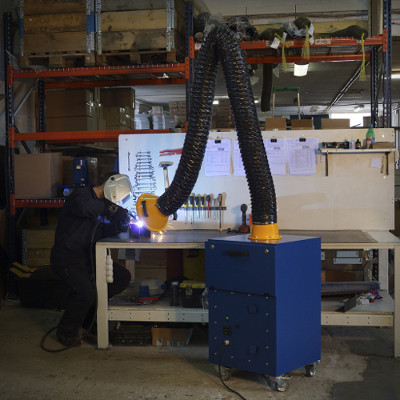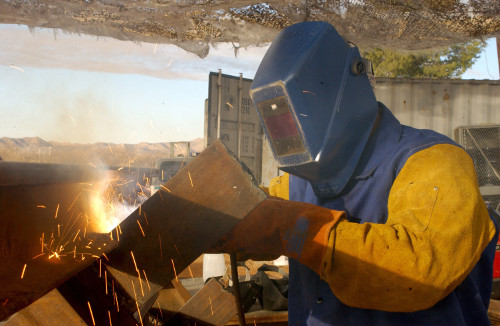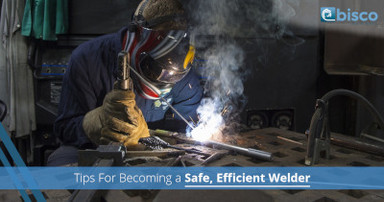Feb 10th 2018
Tips For Becoming A Safe, Efficient Welder
Welding is a delicate, intricate, and in most cases hazardous occupation.
However, being a safe, efficient welder can also be one of the most rewarding careers available.
It can not only help you earn a steady paycheck, but safe and efficient welding can also increase your company’s productivity and reputation around the country.
There’s a lot more to welding than just pushing a button, however. There are a myriad of safety measures that need to be checked off before the process even begins, and there are always ways in which you can improve your craft.
In the following blog, we’ll take a look at a few ways that you (or your employees) can become safer, more efficient welders in order to create a more productive and reputable environment.
Proper Ventilation
Of course, we’re going to start with ventilation as our first tip towards becoming a safer, more efficient welder.
After all, we specialize in modern, industry leading air cleaning and dust collection systems here at Bisco Enterprise, which is why we highly recommend our manual welding fume extractors for all industrial and commercial welding needs.
The hazards of even short-term exposure to welding fumes are well documented by the Occupational Safety and Health Administration, as well as industry experts and leaders. Welding various metals emits fumes and gases which can result in short-term hindrances like eye, nose, and throat irritation, dizziness, nausea, and more, but prolonged exposure to these gases can be much more damaging.
OSHA notes that welding fumes may cause various forms of lung or respiratory damage, including lung cancer, larynx cancer, urinary tract cancer, and more. Certain fumes emitted from welding can also lead to metal fume fever, stomach ulcers, kidney damage, and nervous system damage.
That’s why it’s highly recommended that companies and individual welders alike take a more proactive approach towards reducing exposure to welding fumes.
With that in mind, Bisco Enterprise has developed the solution for safe and efficient manual welding in the industrial setting.

Our portable air cleaners are designed to be very user friendly with many performance features which use powerful two and three stage filtration processes that have a filter efficiency that exceeds 99%. These portables extract welding fumes very well and are perfect for welding and dust applications especially when combined with our self-supporting conventional fume arm.
Our welding and grinding tables are designed to work specifically as effective welding fume extractors, capturing fumes, dust, and other particles emitted by the process of welding. If grounded and installed accordingly, our tables can even be used in explosive environments.
Welding has never been safer or easier than with our welding and grinding table. There is a duct connection for an external fan located on top of the work table, and the table facilitates suspension of your welding torch when it’s not in use. Our three different sizing options each offer their own benefits, from their flexible extraction capacities to their versatile installation possibilities.
We also offer industry leading downdraft tables for efficient, cost-effective control of dust, smoke, fume, and gas air contaminants. These self-cleaning downdraft tables are great for grinding, polishing, or dry buffing, though they can also be used for welding thanks to its efficient slotted back draft option. They are easy to install, extremely maintenance friendly, provide a sturdy workspace, and some even feature a convenient dust drawer underneath the working area which takes care of heavy dust and can be easily emptied.
The first step towards becoming an efficient, safe welder is to have a reliable working area. That’s where Bisco Enterprise comes in. Contact us today to learn more.
Safety Precautions
Even after establishing a proper space for fume extraction to protect against fume inhalation and scattering, the proper welding safety checklist still isn’t yet complete.
We’ve covered welding safety guidelines more in-depth in previous blogs, but as a quick refresher here are a few things to take into account before you start on your welding project:
 Areas to avoid: You should never weld in an area that is unauthorized by management. You should also never weld in an area where sprinklers aren’t available, or otherwise impaired, in explosive atmospheres (unless you have a properly grounded fume extractor), or in wet, damp areas, or those with highly ignitable materials, products, or equipment.
Areas to avoid: You should never weld in an area that is unauthorized by management. You should also never weld in an area where sprinklers aren’t available, or otherwise impaired, in explosive atmospheres (unless you have a properly grounded fume extractor), or in wet, damp areas, or those with highly ignitable materials, products, or equipment.
- Protect your skin: As noted, welding deals with a variety of different metal materials which emit sparks, fumes, and other debris which can severely burn or damage your skin. Be sure to protect yourself by wearing long-sleeved, non-flammable shirts, closed toed shoes, proper welding gloves, and an apron for proper safety. This will help not only protect your skin from sparks but also from UV radiation which can lead to skin cancer and harsh burns that are even worse than sunburns.
- Shield Your Face: One of the defining characteristics of a welder is the big, intimidating mast. However, it’s more than just a fashion statement (or faux pas, depending on your taste). A proper welding mask can protect your eyes and face from not only sparks and fumes, but also harmful ultraviolet radiation that is even brighter than the sun. These rays can cause significant burns and eye damage, all of which can be avoided with a face shield.
- Check Around You: Make sure you’re working in a space that fits the requirements laid out in the first tip, but also make sure there’s no one around you that can be struck by sparks or debris. Remember, metal sparks can bounce, sometimes as far as 35 feet, so check to make sure you aren’t going to hit anyone or anything before you begin.
Technique Tips
Now that we have the safe part locked down, we can focus on becoming a more efficient and skilled welder.
There are many processes and resources available to help you increase your torch handling, but the best tips were offered by Marty Rice from The Fabricator in 2008. In his article called “Becoming The Best Danged Welder On the Block), Rice outlined why a career in welding was so rewarding and how it featured many opportunities for those willing to meet the proper requirements and challenges.
Rice said becoming a better welder will increase your working opportunities, which will lead to a long and lucrative career. In order to do that, he suggested a few tips and tricks, such as:
- Taking a more relaxed hand approach, learning the proper speed, electrode, gun angle, and temperature to use when welding.
- There are many different welding processes out there, from MIG to stick to TIG to fraction stir and more, so learning all you can about the one you plan to practice can help you specialize, but learning the basics of each process will help you become more well-rounded.
- Take a scientific approach by studying metallurgy to learn how you’re affecting and manipulating the base metal you’re welding with.
- Check that your led connections are tight, and use compressed air to blow the gathered dust out of your machine monthly. You should also clean the dust from your work bench on a regular basis.
- NEVER daydream or lose focus, no matter how many times you’ve performed the same task in the same day, week, month, or what have you.
- ALWAYS “keep on learning, learning, learning, and practice by burning, burning, burning.”
Now that you’re ready to implement these tips during employee training or even in your own welding, you can get on the fast track towards productivity.
Contact Bisco Enterprise, the industry experts in proper industrial air cleaning and dust collection for the last 40 years, to learn more about our systems.

